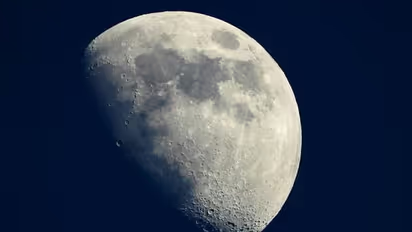China: Chang’e 5 lunar probe discovers first on-site evidence of water on moon

Synopsis
For the first time, a lunar lander technology evaluated the spectral reflectance of regolith and rock and discovered water on the spot.
The first-ever on-site evidence of water on the moon's surface was discovered by China's Chang'e 5 lunar lander, adding to the satellite's dryness. The study, published on Saturday in the peer-reviewed journal Science Advances, showed that the lunar soil around the landing site had less than 120 grammes of water per tonne. Still, a light, vesicular rock has 180 ppm, significantly drier than that on Earth. Although distant observation had shown the presence of water, the lander has now detected water in rocks and dirt.
For the first time, a lunar lander technology evaluated the spectral reflectance of regolith and rock and discovered water on the spot. According to the researchers, the solar wind contributed the most to the humidity of lunar soil by bringing hydrogen, which builds up water. As a result, the rock is thought to have originated from an earlier, more humid basaltic block before being thrown onto the landing site and picked up by the lunar lander.
The moon grew drier over time, most likely owing to the degassing of its mantle reservoir, according to the study. The Chang'e-5 spacecraft landed on one of the moon's youngest mare basalts in a mid-high latitude. It weighed samples weighing 1,731 grammes and measured water on the spot.
Also Read | China announces its space station will be ready this year, plans 40-plus launches in 2022
Lin Honglei, a researcher at the CAS Institute of Geology and Geophysics, told Xinhua that simulating actual lunar surface conditions on Earth is difficult, which is why in-situ measurements are so important. The findings add to the mystique surrounding China's Chang'e-6 and Chang'e-7 missions. According to the sources, as the development of human lunar bases is envisaged for the future decades, the assessment of lunar water supplies comes to the fore.
Also Read | China's extremely powerful 'Artificial Sun' is switched on; Details inside